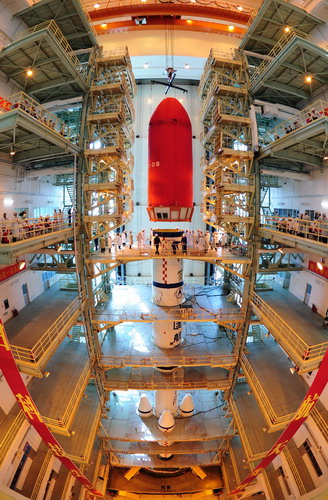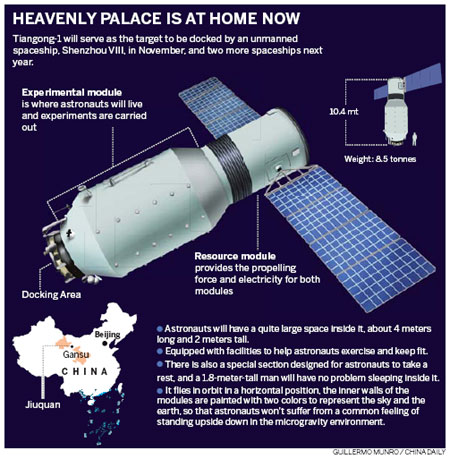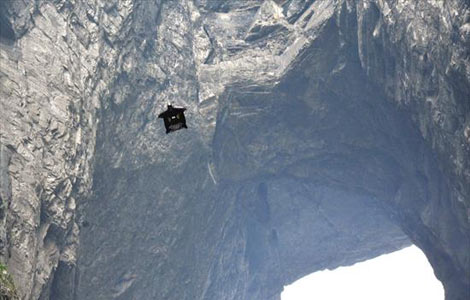All systems go for key space launch
Updated: 2011-09-29 08:26
By Xin Dingding (China Daily)
|
|||||||||
First step in rendezvous and docking mission
JIUQUAN, Gansu - Fuel has been injected into the Long March II-F T1 carrier rocket in preparation for the launch of the Tiangong-1 space module on Thursday night as planned, a spokeswoman for China's manned space program said on Wednesday.
Tiangong-1, or Heavenly Palace, is scheduled to blast off between 9:16 pm and 9:31 pm from Jiuquan Satellite Launch Center in Gansu province. The launch will mark the start of China's first spacecraft rendezvous and docking mission, Wu Ping said at a news conference.
The unmanned spacecraft will be sent into an orbit some 350 kilometers above Earth for in-orbit testing.
|
 The Tiangong-1 space module is lowered onto the Long March II-F T1 rocket at the Jiuquan Satellite Launch Center in Gansu province on Sept 18. [Photo by Su Dong/for China Daily]
|
This is because when it enters orbit and deploys its solar panel, some 10 minutes after the launch, it will be on the dark side of Earth. It will be another 30 minutes or so before ground control can gauge if all systems are working, said Sheng Jie, deputy chief engineer of the Jiuquan Satellite Launch Center.
Wu explained the technicalities behind the rendezvous and docking maneuvers, vital procedures for any space station program.
According to the plan, Tiangong-1 will descend to a 343 kilometer orbit days prior to the launch of the unmanned Shenzhou VIII spaceship in early November. Two days after the Shenzhou VIII launch, the two craft will rendezvous and dock for the first time. They will stay docked for 12 days before decoupling. A second rendezvous and docking will be conducted some time later this year.
Shenzhou VIII will then return to Earth somewhere in the Inner Mongolia autonomous region.
Tiangong-1 will stay in orbit for two more rendezvous and docking missions next year. At least one of these missions will be manned, Wu said.
According to the manned space program, China will build its space lab before 2016, and assemble its 60-ton space station around 2020.
"Moreover, the technology can be used for moon landings and deep space exploration though China is only doing concept research and preliminary feasibility studies on manned moon landings, without a timetable," she said.
The mission does face challenges. Rockets must deliver spacecraft precisely into orbit and some new devices onboard Tiangong-1 can only undergo testing in space, she said. 
China Aerospace Science and Technology Corp, which developed Tiangong-1, the Shenzhou spaceships and rocket carriers, has built a backup craft, Tiangong-2, said Tong Xudong, director of the manned space engineering office of the corporation.
Compared to the Soviet Union and the United States when they were conducting these experiments, China's space mission has many advantages.
Russia and the US launched pairs of spaceships to experiment with rendezvous and docking. China, however, has designed a two-year target spacecraft for docking experiments with three spaceships, the manned space program chief designer Zhou Jianping said.
"Tiangong-1's cost is similar to that of a spaceship we only need four launches and can experiment with rendezvous and docking three times," he said.
The Soviet Union and the US, in the early stages of their space race, would have needed six launches to carry out three experiments, entailing greater cost, Zhou said.
Tiangong-1 has another advantage in that it will stay in orbit for two years, much longer than a spaceship. This will provide a crucial platform to conduct experiments and verify key technology toward building a space station, he said.











